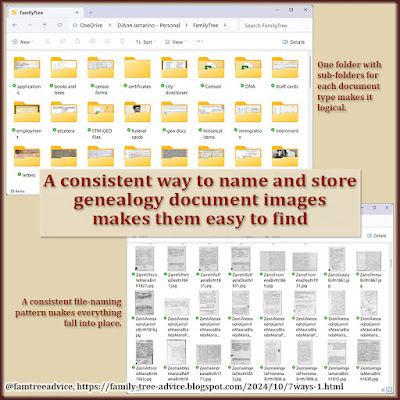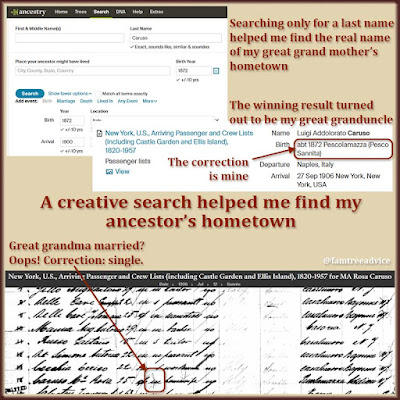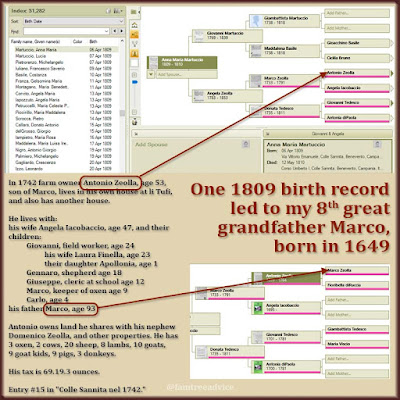The Ellis Island website was my first stop when I became interested in genealogy. After I found my grandfathers' ship manifests, I looked for people with my closest ancestors' last names. I recorded everything I found in a notebook.
Then a friend turned me on to Family Tree Maker and Ancestry.com. From that point on, I stopped filling notebooks and filled my Family Tree Maker file instead. Each discovery, document, and photograph needs to be in your family tree. Unless you're keeping a 100% paper family tree, that means you need to digitize everything.
Are you looking for a compelling reason to digitize all your genealogy holdings? Here are 4 of them, with a cute acronym—PEAS.
 |
| Go fully digital to protect your family tree and reap the benefits. |
1. Protection
I have so few paper genealogy documents they fit in one file folder. They include hard copies of some of my ancestors' U.S. vital records. I keep them in a metal safe.
By keeping all your genealogy work in digital format, you can better protect it from harm or loss. I build my tree in Family Tree Maker, attaching important documents to the tree. Each day when I'm finished working on my tree, I:
- export a GEDCOM file
- create a smaller backup with no media files attached
- create a large backup file with all media files attached
- copy these files, the Family Tree Maker file, and its automatic backup file to the cloud.
All these files become part of my weekly backup plan so they're kept on two external hard drives as well as the cloud.
I store my tons of document images on OneDrive. These include vital records, censuses, ship manifests, naturalization documents, and much more. Whenever I add a new document image, I capture it in my weekly backup routine.
My genealogy work can survive any catastrophe that might happen to my computer.
2. Efficiency
I've seen people debate the best type of binders to use for their genealogy research. Binders? My family tree has 83,000 people and will continue to grow. Saving my work as paper printouts in binders is crazy. I'd need a second house to hold them all, and a ton of money for the materials.
I did fill one accordion folder with large printouts of my closest ancestors' papers long ago. I thought I'd bring it to family gatherings. That only happened once. I run a 98% paper-free office. No clutter allowed.
Efficiency means it's easy to take all my work with me.
3. Access
When I visit my mother, she always has some random question about the family. "Where did Uncle Silvio live when he went to high school?" That's not something I know off the top of my head. But I have my iPhone, and I can find his 1940 census page on OneDrive. She's always asking me when someone's birthday is, or how old they'd be if they were alive. I can pull up my tree on Ancestry.com to answer those questions.
At home, I work on my family tree using a tower computer, not a laptop. I keep a laptop to take with me when I travel. It's fantastic to be able to access every bit of my work from that computer using OneDrive. On one trip, I renamed downloaded vital records to make them searchable. Since the files are on OneDrive, the changes I made synchronized to my tower computer when I got home.
4. Searchability
As I mentioned above, I rename downloaded files to make them searchable on my computer. I have huge collections of Italian vital record images from my ancestral hometowns. Because I've renamed them, I can find what I need in a second. I use a Windows-based program called Everything to show me every result.
 |
| Name your genealogy files in a way that improves your search results. |
Let's say I've added the 1814 marriage of Pietro Mazzone and Vita Nicola Tosto to my family tree. Now I want to find and add all their children. Because of the naming style I use, I can search for all their children at once.
In the Everything program, I type "Mazzone di Pietro to find:
- his 6 children's births
- 3 of their deaths
- 7 of their marriages
Each result is clickable, opening the document image.
This is possible because I renamed the files with the person's name and their father's name. (I use the Italian word di, meaning of, before the father's name as a shorthand.)
With consistent file naming, you can search for and find whatever you need.
Let's Get Digital
Now here's your challenge. Come up with a concrete timetable that works for you, and:
- Scan or digitally photograph all your paper documents and photographs. Then name and store the files using a logical system that makes sense to you.
- Rename and organize all your downloaded genealogy document images. Depending on your preference, you can store the files by file type of document or by family name.
- Use HandwritingOCR to capture text from handwritten or printed pages. Save them as text files. You can save the text of newspaper articles in an individual's notes section in your family tree. If you have handwritten notes, capture their text to make it more usable.
- Follow a weekly plan to keep digital backups in more than one location. If you don't work on your family tree each week, you can follow a monthly backup plan. Use external hard drives and cloud storage to help ensure the safety of your data.
- Export a GEDCOM file from your family tree each time you work on it. Keep this file safe and make it part of your regular backup plan.
Now's the time. Reduce your reliance on paper and safeguard your assets. Make your genealogy research thoroughly modern.













